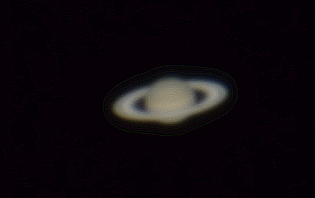
Hawk, ISS, Comet ISON, Dark Sky Meter Lite, Saturn
Posted: 28 April 2013
Cassiopeia Observatory was opened Saturday, 27 April 2013, at 1832 MST, 91°F. The sky was clear, with a slight breeze blowing. I powered on the 8" LX200-ACF at 1840 MST. At 1842 MST, photographed this red-tailed hawk flying near the observatory (highly cropped from full-frame):

I then updated the ISS TLE for the night's good pass. At 1859 MST, viewed Venus, 83X, low and in a tree. At 1915 MST, slewed to Sirius, mounted the D7000 DSLR at prime focus + 2X Barlow Lens, then tweaked the finderscope alignment. I wanted to try for more magnification of the ISS than I used on my recent ISS imaging sessions, hence the use of the 2X Barlow Lens. This night would be a test of the exposure setting. At 1932 MST, did a focus test on Sirius using the Bahtinov Mask; locked the telescope focus. I was now ready for the ISS pass. The pass began at 2005 MST. Initial pointing was way off, but once I centered the ISS in the illuminated crosshairs finderscope, tracking was generally good. Unfortunately, the exposure setting I used for the HD video recording, 1/2000sec, ISO 3200, was underexposed. Some structure is visible in these six views captured from the 5m11s video:

The images show the changing perspective as the ISS moved across the sky. I will try 1/2000sec, ISO 5000, on my next ISS imaging attempt. However, that will be awhile as this night was the last of the current series of good passes.
I then began preps for imaging Comet C/2012 S1 (ISON). I mounted the D7000 DSLR at prime focus of the 8" telescope using the off-axis guider. Did a focus test with the Bahtinov Mask on the star Capella. I then powered on the GC Wi-Fi Adapter and used SkySafari Pro on the iPhone 4 to GOTO the comet. I found a good guide star and did 10 minute, ISO 6400, guided exposures at 2035 MST and 2105 MST. Seeing was not ideal as the guide star did a lot of dancing around inside the reticle eyepiece "box". The top image below (cropped from the full-frame image) shows the comet, Mag. +14.9. The inset shows a magnified view. The bottom image shows the movement of Comet ISON over 30 minutes.


Some slight field rotation is evident. I will tweak the telescope mount polar alignment using "drift align" on a future session.
During the time between doing the two Comet images, I did a sky darkness measurement using the newly released Dark Sky Meter Lite (free) on my iPhone 4.

The moon would not rise for an hour and astronomical twilight had ended, so I figured this was a good time to try the app. Using the app is simple by following the onscreen instructions. As seen above, you first cover the camera lens (I used my hand) and tap "Dark". That calibrates the camera to total darkness. When prompted, you aim the camera at the sky (I pointed the camera at the zenith) and tap "Sky":


I had several "Invalid" results, as seen on the right above. I checked the app Help:

However, nothing in the Help discussed the Invalid result. I kept trying to get a measurement and finally did:

I submitted the result to the IDA. However, the results shown seem incorrect for my location. It describes my "sky" as a "Bright Suburban Sky" with the Milky Way only visible near the zenith. In fact, I can view the Milky Way generally horizon to horizon, and when it is best, I can view the zodiacal light nearly to the zenith. I expected that the app would show its measurements using either the "Bortle Dark-Sky Scale" or as a limiting visual magnitude. My Bortle Dark-Sky Scale value is 3, with my limiting visual magnitude approaching +7, so maybe the app is being overly conservative (and the "4 times as bright" is indeed the Bortle-Scale value it determined). I will continue to use the app; maybe the measurements will vary night-to-night. If you use iOS, you should give the app a try and submit your results to the International Dark-Sky Association.
At 2115 MST, the eastern sky was beginning to brighten from the about to rise waning gibbous moon. I removed the camera, attached the 2" 24mm UWA eyepiece (83X), and slewed to Saturn. I could see the moons Titan, Dione, Rhea, Tethys, Enceladus, and Iapetus. I mounted the D7000 DSLR at prime focus + 3X TeleXtender and did some HD video recordings, 45 seconds, at 1/30sec, using various ISO values. This is a stack of 989 frames, 1/30sec, ISO 5000:

Completed imaging at 2156 MST.
Closed the observatory at 2210 MST, 68°F.
Comments are welcome; use the Comments section below, or you can Email Me. Thanks.
Cassiopeia Observatory Home Page